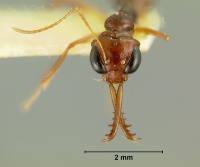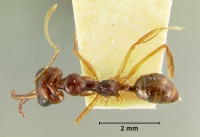Myrmoteras barbouri
| Myrmoteras barbouri | |
|---|---|

| |
| Scientific classification | |
| Kingdom: | Animalia |
| Phylum: | Arthropoda |
| Class: | Insecta |
| Order: | Hymenoptera |
| Family: | Formicidae |
| Subfamily: | Formicinae |
| Tribe: | Myrmoteratini |
| Genus: | Myrmoteras |
| Species: | M. barbouri |
| Binomial name | |
| Myrmoteras barbouri Creighton, 1930 | |
| Synonyms | |
| |
Workers have been found in forest leaf litter and are presumed, based on their behavior, to be predacious (Moffett 1986).
Identification
Moffett (1985) - Myrmoteras barbouri is readily distinguished from all other species in the binghami group by its conspicuous granulate sculpturing.
Workers from Borneo and peninsular Malaysia are similar to the Javanese holotype (including palpal segmentation of 5,3 in all workers examined), but, with the exception of the queen described above, are significantly smaller (HW for workers 1.01 to 1.07 mm; TL 5.8 to 6.1 mm, except Singapore specimen 5.5 mm) and with slightly narrower heads (CI 92 to 96 for all workers); fine rugae on metanotum transverse (continuing partially down sides in Singapore specimen); metanotal groove conspicuously impressed; and with petiole node similar to that described for Myrmoteras binghamii: less massive and with a steeper posterior face than in holotype. The Singapore specimen has an exceptionally narrow petiole node. Specimens from Borneo are slightly darker in color, have a more strongly developed iridescence and a somewhat stronger granulate sculpturing (but still not as strong as in Myrmoteras ceylonicum); the sculpture continues on occiput (and even feebly beneath head on Sabah queen described above) and on to sides of pronotum and propodeum.
Keys including this Species
Distribution
Latitudinal Distribution Pattern
Latitudinal Range: 1.383329988° to 1.383329988°.
| North Temperate |
North Subtropical |
Tropical | South Subtropical |
South Temperate |
- Source: AntMaps
Distribution based on Regional Taxon Lists
Indo-Australian Region: Borneo, Indonesia (type locality), Malaysia, Singapore.
Distribution based on AntMaps
Distribution based on AntWeb specimens
Check data from AntWeb
Countries Occupied
| Number of countries occupied by this species based on AntWiki Regional Taxon Lists. In general, fewer countries occupied indicates a narrower range, while more countries indicates a more widespread species. |

|
Estimated Abundance
| Relative abundance based on number of AntMaps records per species (this species within the purple bar). Fewer records (to the left) indicates a less abundant/encountered species while more records (to the right) indicates more abundant/encountered species. |

|
Biology
Life History Traits
- Mean colony size: 8 (Moffet, 1986; Beckers et al., 1989)
- Foraging behaviour: solitary forager (Moffet, 1986; Beckers et al., 1989)
Castes
Nomenclature
The following information is derived from Barry Bolton's Online Catalogue of the Ants of the World.
- barbouri. Myrmoteras barbouri Creighton, 1930a: 185, fig. 2; pl. 11, fig. 6 (w.) INDONESIA (Java). Moffett, 1985b: 21 (q.). Combination in M. (Myrmoteras): Moffett, 1985b: 20. Senior synonym of kemneri: Moffett, 1985b: 20. See also: Moffett, 1986b: 85.
- kemneri. Myrmoteras kemneri Wheeler, W.M. 1933e: 73, fig. 1 (w.) INDONESIA (Java). Junior synonym of barbouri: Moffett, 1985b: 20.
Unless otherwise noted the text for the remainder of this section is reported from the publication that includes the original description.
Moffett (1985):
Description
Worker
Holotype: TL 6.7, HW 1.28, HL 1.25 (CI 102), ML 1.58 (MI 126), SL 1.56 (SI 122), EL 0.76, HFL 1.68 (TWI 21), WL 1.86 mm. Frontal sulcus very feeble, discernible only to height of antennal bases. Palpal segmentation 5,3. Mandibles with 10 teeth and one preapical denticle; apical pair of denticles on both mandibles apparently worn off or broken (not absent as has been supposed by Creighton [1930] and others). Other material of this species has mandibles with 9 to 11 teeth (usually 10) and 1 to 2 preapical denticles (usually 1). The denticle between the penultimate tooth and the one proximad to it is almost half the height of the adjacent teeth and is thus unusually prominent (much less than half the height in other species).
Pronotum slightly flattened above; propodeum evenly convex. Metanotal groove not visible as a conspicuously impressed notch in profile. Node of petiole high and massive, in side view with sloping, straight to slightly concave anterior and posterior faces and with summit narrow relative to base and somewhat flattened (moderately rounded above when viewed from the front). Ventral margin of petiole feebly convex beneath node.
Dorsal surface of head granulate, grain very even and fine (diameters ca. 0.01 to 0.02 mm), similar to Myrmoteras ceylonicum but more delicate; clypeus medially more feebly granulate; back of head virtually smooth. Sculpture on pronotum and propodeum similar to dorsum of head but relatively feeble, particularly on sides; in some lights propodeum appearing to have very feeble transverse rugae across dorsum. Mesothorax with several weak to moderately strong oblique rugae on sides, virtually smooth, but with traces of fine longitudinal rugae dorsally. Pilosity moderately dense, with 20 hairs breaking dorsal margin of trunk in profile. Hairs short, rising 0.08 mm on head and 0.13 mm on trunk and gaster. Two hairs on or near each metathoracic tubercle, node of petiole with ca. 4 to 8 hairs. Reddish orange, with gaster and antennae yellowish orange, legs same but darker; petiole and mandibles orange.
Queen
Previously undescribed. A single dealate queen from Sabah is tentatively identified with this species. TL 6.9, HW 1.22, HL 1.25 (CI 98), ML 1.69 (MI 136), SL 1.48 (SI 121), EL 0.77, HFL 1.59 (TWI 20), WL 1.93 mm. Granulate sculpture similar but relatively stronger than holotype, as in other material from Borneo (see below). Trunk granulate dorsally, much more feebly granulate on sides; propodeum conspicuously sculptured, transversely granulo-rugose dorsally, obliquely so on sides, with declivity virtually smooth. Uniform rich dark orange red, mandibles, antennae and legs slightly lighter.
Type Material
Java, Singdanglaha [Sindanglaja?], 1 worker (T. Barbour, Museum of Comparative Zoology [examined]).
References
- Beckers R., Goss, S., Deneubourg, J.L., Pasteels, J.M. 1989. Colony size, communication and ant foraging Strategy. Psyche 96: 239-256 (doi:10.1155/1989/94279).
- Creighton, W. S. 1930a. A review of the genus Myrmoteras (Hymenoptera, Formicidae). J. N. Y. Entomol. Soc. 38: 177-192. (page 185, fig. 2, pl. 11, fig. 6 worker described)
- Moffett, M. W. 1986b. Trap-jaw predation and other observations on two species of Myrmoteras (Hymenoptera: Formicidae). Insectes Sociaux. 33:85-99. (page 85, see also)
- Moffett, M.W. 1985b. Revision of the genus Myrmoteras (Hymenoptera: Formicidae). Bulletin of the Museum of Comparative Zoology. 151:1-53. (page 21, queen described; page 20, Combination in M. (Myrmoteras), and senior synonym of kenneri)
- Wang, W.Y., Soh, E.J.Y., Yong, G.W.J., Wong, M.K.L., Benoit Guénard, Economo, E.P., Yamane, S. 2022. Remarkable diversity in a little red dot: a comprehensive checklist of known ant species in Singapore (Hymenoptera: Formicidae) with notes on ecology and taxonomy. Asian Myrmecology 15: e015006 (doi:10.20362/am.015006).
References based on Global Ant Biodiversity Informatics
- Agosti D. 1992. Revision of the ant genus Myrmoteras of the Malay Archipelago (Hymenoptera, Formicidae). Rev. Suisse Zool. 99: 405-429.
- Agosti, D. 1992. Revision of the ant genus Myrmoteras of the Malay Archipelago (Hymenoptera, Formicidae). Rev. Suisse Zool. 99: 405-429
- Chapman, J. W., and Capco, S. R. 1951. Check list of the ants (Hymenoptera: Formicidae) of Asia. Monogr. Inst. Sci. Technol. Manila 1: 1-327
- Creighton W. S. 1930. A review of the genus Myrmoteras (Hymenoptera, Formicidae). Journal of the New York Entomological Society 38: 177-192.
- Gregg R. E. 1954. Geographical distribution of the genus Myrmoteras, including the description of a new species (Hymenoptera: Formicidae). Psyche (Cambridge) 61: 20-30.
- Hashimoto Y., Y. Morimoto, and M. Mohamed. 2003. Species List of Ground and Leaf Litter Ants Collected in Lower Kinabatangan. Pp 13-18. In Lower Kinabatangan Scientific Expedition 2002, 176 pp. ISBN-13: 983-2369-11-8
- Moffett M.W. 1985. Revision of the genus Myrmoteras. Bulletin of the Museum of Comparative Zoology 151: 1-53.
- Pfeiffer M.; Mezger, D.; Hosoishi, S.; Bakhtiar, E. Y.; Kohout, R. J. 2011. The Formicidae of Borneo (Insecta: Hymenoptera): a preliminary species list. Asian Myrmecology 4:9-58
- Wheeler W. M. 1933. A new Myrmoteras from Java. Proceedings of the New England Zoological Club 13: 73-75.
- Zettel H., and Sorger, D. M. 2011. New Myrmoteras ants (Hymenoptera: Formicidae) from the southeastern Philippines. Raffles Bulletin of Zoology 59:61-67.

